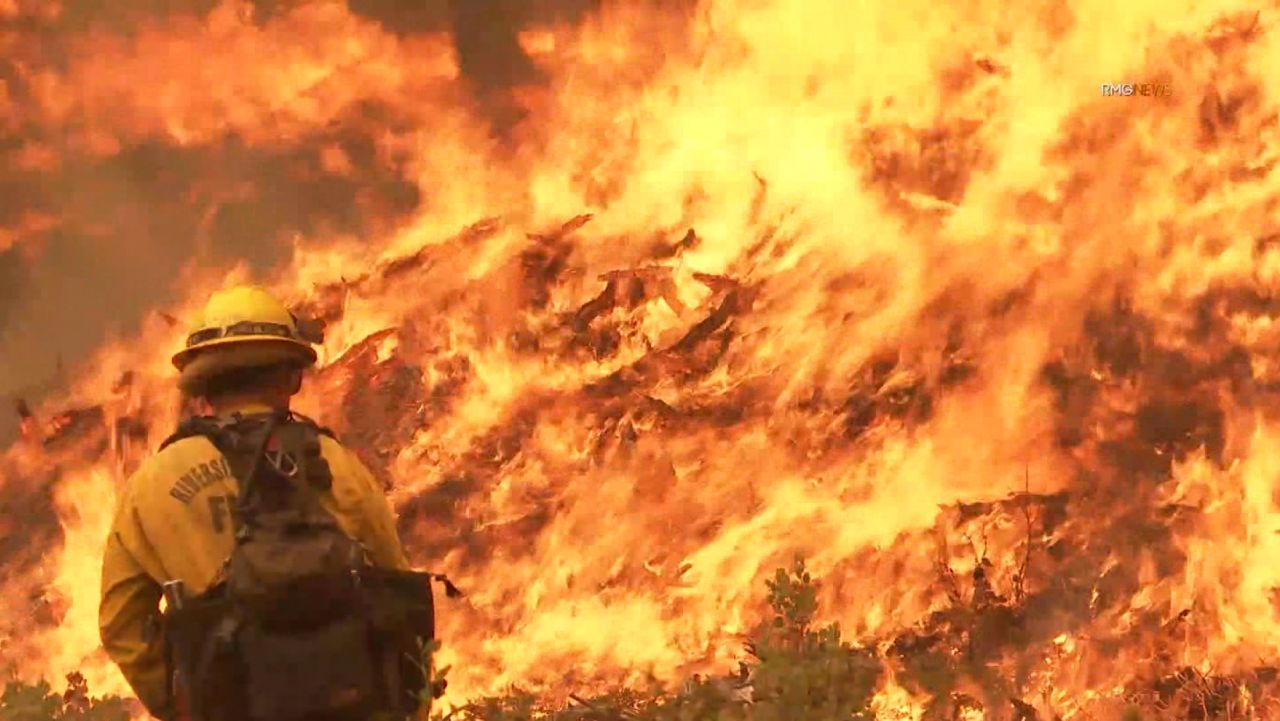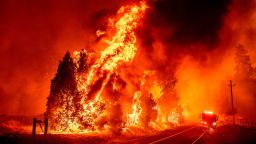For more on the fires, “United Shades of America with W. Kamau Bell” heads to California to discover how communities are learning to coexist with the frequent destruction. The Original Series airs Sunday at 10 p.m. ET.
A ferocious wildfire outside California’s Yosemite Park is “moving extremely fast” and limiting the amount of time authorities have to warn area residents to evacuate, a state fire official said.
“The fire behavior that we’re seeing on this incident is really unprecedented,” Cal Fire Battalion Chief Jon Heggie said of the Oak Fire, which has exploded to more than 16,700 acres and destroyed at least seven structures. “It’s moving extremely fast and the reaction time to get people out is limited because that fire is moving so fast.”
At least 3,000 people have been forced to evacuate their homes due to the fire, per a news release from Gov. Gavin Newsom’s office Saturday, since it began Friday in the foothills of the Sierra Nevada.
In all, more than 2,500 personnel are battling the fire, which is 10% contained, according to an update Monday from Cal Fire. The teams are utilizing more than a dozen helicopters, 281 fire engines and 46 water tenders, which are used to transport large amounts of water, the agency said.
Officials, Heggie added, are doing their best to work with law enforcement and notify residents when they need to leave.
“But the reality is, it’s moving so quickly, it’s not giving people a lot of time, and they are sometimes just going to have to evacuate with the shirts on their back,” he said. “But their life, safety is obviously the most important thing.”
The fire “remained active in some areas” through Sunday night “due to dry dead and downed fuels,” Cal Fire’s update Monday said.
The agency also revised down the number of structures destroyed from 10 to seven and the number of structures damaged from five to zero, calling earlier figures “a preliminary estimate.”
Among those who lost their home were Jane and Wes Smith, their son Nick Smith said, telling CNN his parents were left with “just the clothes on their back and the shoes on their feet.”
“It’s pretty sad to see the house that I grew up in and was raised in gone,” he said. “It hits hard.”
His mother only had enough time to load up their horses before escaping the area, Smith said, while his father was busy working on the fire as a Mariposa County sheriff’s deputy. Now, the couple is staying with friends and family as they recover from the loss.
Smith started a GoFundMe to support his parents’ recovery, writing, “37 years of memories, generations of family treasures, and countless more sentimental things. Although these are materials, it is devastating to lose everything literally in the blink of an eye without notice.”
Fire’s severity is the ‘direct result’ of climate change, official says
Newsom declared a state of emergency for Mariposa County Saturday, citing the thousands of displaced residents, destroyed homes and threatened critical infrastructure.
An evacuation center has been established at Mariposa Elementary School, as well as a small animal shelter. The county fairgrounds and Coursegold Rodeo Grounds are serving as a shelter for large animals, according to the sheriff’s office.
Parts of the Sierra National Forest, which flanks and partially overlaps with Mariposa County, are closed to the public due to the fire, the Forest Service announced Sunday.
“The Fire’s behavior consists of flanking, backing, and creeping through National Forest Systems lands, roads, and recreational areas,” the agency posted on its website. “This closure will support public safety by keeping public members out of hazardous burn areas and will allow firefighting resources to combat the Fire without public interference.”

The Oak Fire is the largest of California’s actively burning fires, which have been fueled by extended drought conditions in much of the state, leaving behind brittle vegetation and underbrush which is quick to burn.
The fire is also having an affect on the weather in other states. The National Weather Service in Portland, Oregon, noted in a tweet that high temperatures may be impacted or lowered if the smoke from the Oak Fire reaches their city.
Heggie also noted the fire was “indicative” of what’s been seen more broadly in wildfires throughout the state and the American west in recent years: It was “burning with just such a velocity and intensity,” Heggie said, due to prolonged drought and human-caused climate change.
“What I can tell you is this is a direct result of what is climate change,” he said. “You can’t have a 10-year drought in California and expect things to be the same. And we are now paying the price for that 10-year drought and that climate change.”
As a result of climate change, wildfires are becoming more frequent and severe. Blazes are burning longer and hotter in places they’ve always occurred, according to a report released earlier this year from the UN Environment Programme, and also igniting in unexpected places.

“That dead fuel that’s a result from that climate change and that drought is what’s driving these, what we are now calling, ‘mega fires,’” Heggie said.
In years past, he said, fires “had never grown in this rate or this size.”
“Now,” he observed, “it’s commonplace.”
Cal Fire acknowledges the state’s longer wildfire seasons, which experts say are beginning to stretch throughout the year, are the direct result of climate change.
Fire officials in Southern California braced for a difficult summer this year, anticipating the hotter, drier summer and the increased frequency of wildfires, even as firefighting crews experience worker shortages.
CNN’s Stella Chan, Chris Boyette, Sara Smart and Michelle Watson contributed to this report.






